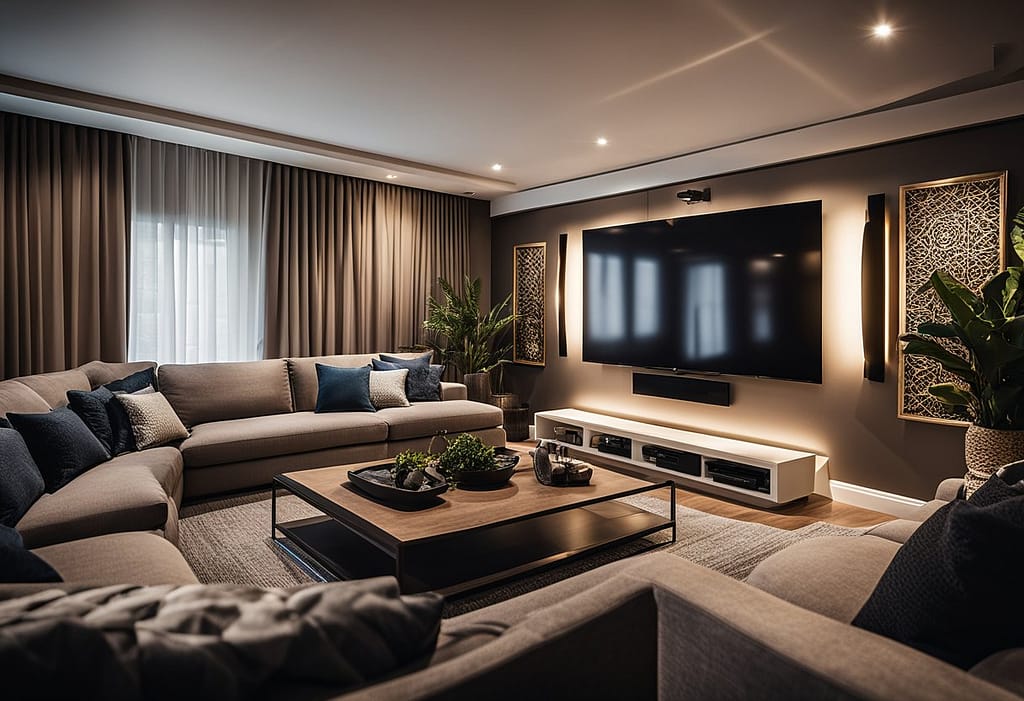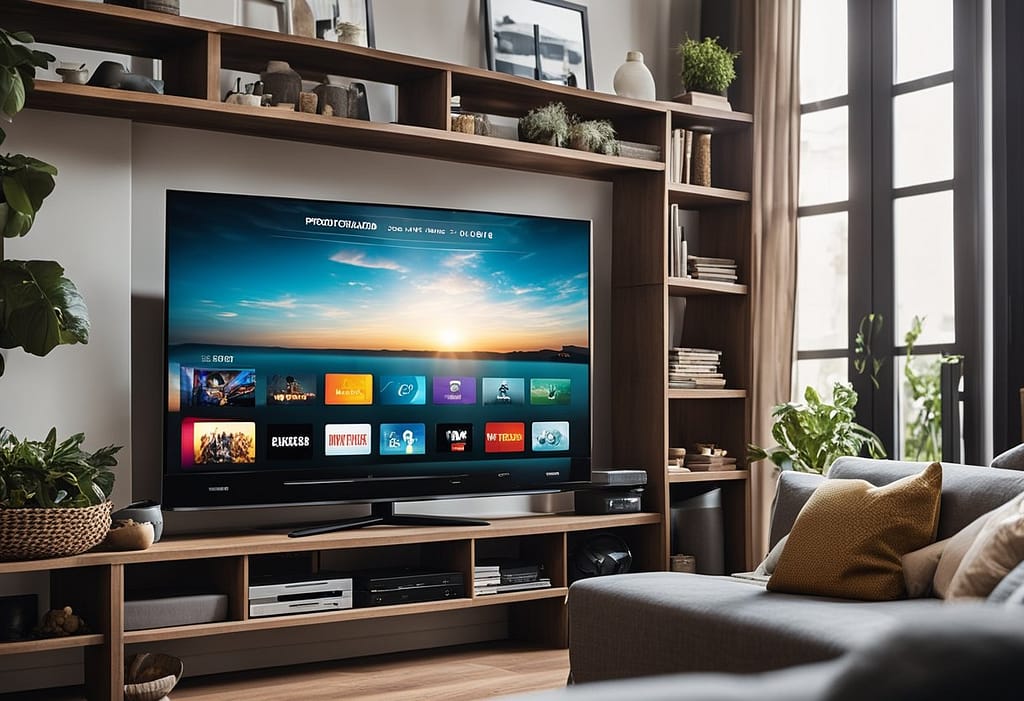
25 Affordable Home Entertainment Accessories: Best Budget-Friendly Picks Under $30
Are you looking for ways to create an immersive home entertainment experience without breaking the bank? With the right planning and equipment, it’s possible to build a budget-friendly home theater setup that delivers high-quality sound and visuals. In this article, we’ll explore the world of affordable home entertainment and provide tips on how to get the most out of your setup.

To begin, we’ll cover the basics of home theater and the key technologies that make it possible. Understanding these concepts is essential for building a setup that meets your needs and budget. From there, we’ll dive into the specifics of building a budget-friendly home theater, including tips on selecting equipment, optimizing your space, and finding affordable sources of entertainment content. Whether you’re starting from scratch or looking to upgrade your existing setup, we’ll provide the guidance you need to create an immersive home entertainment experience without breaking the bank.
Key Takeaways
- Building a budget-friendly home theater setup is possible with the right planning and equipment.
- Understanding the basics of home theater and key technologies is essential for creating a setup that meets your needs and budget.
- Tips on selecting equipment, optimizing your space, and finding affordable sources of entertainment content can help you get the most out of your setup.
25 Top-Rated Affordable Home Entertainment Accessories
| Short Name | Rating | Price |
|---|---|---|
| Power Strip Surge Protector – SUPERDANNY | 4.8 | $24.99 |
| Belkin Power Strip Surge Protector | 4.8 | $20.99 |
| Surge Protector Power Strip – DEPOW | 4.8 | $32.98 |
| Surge Protector Power Strip – Anker | 4.8 | $29.99 |
| ZAONOOL Wall Mount for Nintendo Switch | 4.8 | $21.99 |
| VCE Brush Wall Plate with Bracket | 4.7 | $9.99 |
| Power Strip with USB C – Addtam | 4.7 | $17.99 |
| Alex Tech Cord Protector | 4.7 | $8.99 |
| Cratree HDMI Cables 15FT Long | 4.7 | $18.99 |
| USB Wall Charger Surge Protector – Addtam | 4.7 | $16.99 |
| Flat Plug Extension Cord – 5ft | 4.7 | $12.99 |
| 【2 Pack】 Universal Remote for Vizio TV | 4.7 | $9.99 |
| Maxpw Power Strip Surge Protector | 5.0 | $34.99 |
| OYIB Bluetooth Shower Speaker | 4.6 | $23.99 |
| Acer USB C Hub | 4.6 | $17.99 |
| Outlet Extender with Night Light | 4.6 | $16.97 |
| Switch Games Organizer Station – Kytok | 4.6 | $32.99 |
| Power Strip, SUPERDANNY with 22 Outlets | 4.8 | $32.98 |
| Under Desk Cable Management Tray | 4.6 | $18.99 |
| N NOROCME 192 PCS Cable Management Kit | 4.6 | $14.99 |
| No Stud TV Wall Mount | 4.6 | $12.72 |
| UGREEN Tablet Pillow Stand | 4.6 | $25.99 |
| ZYK Replacement for LG Magic Remote | 4.6 | $17.19 |
| Eanetf RCA Cables | 4.3 | $8.99 |
| JOTO Cable Management Sleeve | 4.5 | $9.99 |
*Note: Prices and availability are subject to change based on the seller’s stock and pricing adjustments. Amazon Affiliate Link.
Understanding Home Theater Basics
When it comes to home entertainment, a home theater system is a great way to enjoy movies, TV shows, and video games in the comfort of your own home. In this section, we will cover the basics of home theater systems, including the audio and video components.
Audio Components
The audio components of a home theater system are essential for creating an immersive experience. The most basic surround sound speaker system consists of 5.1 channels. The “5” stands for speakers in the front left, center, front right, rear right, and rear left positions, while the “.1” refers to the subwoofer that provides the bass. For a more advanced system, you can opt for a 7.1 or even a 9.1 setup.
When selecting speakers, it’s essential to consider the size of your room. Larger rooms may require larger speakers to fill the space with sound adequately. Additionally, the placement of the speakers is crucial to create a balanced soundstage. For instance, the center speaker should be placed directly below or above the TV to ensure clear dialogue.
Video Components
The video components of a home theater system are equally important for creating an immersive experience. The centerpiece of your home theater will be your TV or screen. When selecting a TV, there are several factors to consider, including size, resolution, and picture quality.
For a seating distance of 8 to 12 feet, a 75-inch screen is perfect. Step up to an 85-inch screen if you have another foot or two, between 9 and 14 feet. For either of these sizes, a TV will provide a better picture quality than a projector. However, if you have a larger room, a projector may be a better option.
When it comes to picture quality, it’s essential to consider the resolution. 4K resolution is becoming the standard for home theater systems, but 1080p is still a viable option. Additionally, technologies like HDR (High Dynamic Range) and OLED (Organic Light Emitting Diode) can enhance the picture quality further.
In conclusion, understanding the basics of home theater systems is essential for creating an immersive entertainment experience. By selecting the right audio and video components, you can enjoy movies, TV shows, and video games in the comfort of your own home.
Key Technologies in Home Entertainment

When it comes to home entertainment, there are several key technologies that can greatly enhance your viewing and listening experience. In this section, we will discuss two of the most important technologies: audio enhancements and video enhancements.
Audio Enhancements
One of the most important aspects of a great home entertainment system is high-quality audio. There are several technologies that can help improve the sound quality of your home theater system, including Dolby Atmos and Bluetooth.
Dolby Atmos is a surround sound technology that allows sound to be placed and moved in a three-dimensional space. This technology creates a more immersive audio experience, making it feel like the sound is coming from all around you. Many modern movies and TV shows are now being produced with Dolby Atmos soundtracks, making it a must-have technology for any home theater system.
Bluetooth is another important technology for home audio. It allows you to wirelessly connect your smartphone, tablet, or other devices to your home entertainment system. This makes it easy to stream music and other audio content from your phone or tablet directly to your speakers.
Video Enhancements
In addition to audio enhancements, there are also several technologies that can improve the quality of your home entertainment system’s video. Two of the most important technologies are 4K and HDMI.
4K is a resolution standard that offers four times the number of pixels as standard high-definition video. This means that 4K video is much sharper and more detailed than standard HD video. Many modern TVs and home theater projectors now support 4K resolutions, making it a great technology to invest in if you want the best possible picture quality.
HDMI is a connectivity standard that allows you to connect your home entertainment system components together. It supports high-definition video and audio, making it essential for any modern home theater system. Many modern TVs and home theater receivers now support HDMI 2.1, which offers even higher bandwidth and support for advanced features like Dolby Vision.
Overall, these technologies can greatly enhance your home entertainment experience. By investing in high-quality audio and video components that support these technologies, you can create a home theater system that rivals even the best movie theaters.
Building a Budget-Friendly Setup
When it comes to setting up an affordable home entertainment system, there are a few key things to consider. In this section, we’ll discuss how to choose the right equipment and some cost-saving tips.
Choosing the Right Equipment
When building a budget-friendly setup, it’s important to choose equipment that offers the best value for your money. Here are some things to keep in mind:
- Soundbar or Receiver? A soundbar is a great option for those on a tight budget, as it provides good sound quality without the need for a separate receiver. However, if you’re looking for a more immersive experience, a receiver and separate speakers may be a better option.
- Subwoofer or No Subwoofer? A subwoofer can add depth and richness to your audio experience, but it’s not always necessary. If you’re on a tight budget, consider skipping the subwoofer and investing in a better soundbar or speakers instead.
- Blu-ray Player or Streaming Device? While a Blu-ray player can provide higher quality video and audio, a streaming device like a Roku or Amazon Fire Stick can be a more affordable option. Plus, streaming devices offer access to a wide variety of content, including popular streaming services like Netflix and Hulu.
Cost-Saving Tips
Here are some cost-saving tips to help you build a budget-friendly home entertainment system:
- Buy Used Equipment: Consider buying used equipment, such as speakers or a receiver, to save money. You can often find great deals on sites like eBay or Craigslist.
- Shop for Deals: Keep an eye out for sales and deals on home entertainment equipment. Many retailers offer discounts during major shopping holidays like Black Friday and Cyber Monday.
- Use What You Already Have: Before you start buying new equipment, take inventory of what you already have. You may be able to repurpose existing equipment, such as an old stereo receiver, to save money.
In conclusion, building a budget-friendly home entertainment system is all about making smart choices and being resourceful. By choosing the right equipment and following these cost-saving tips, you can enjoy a great audio and video experience without breaking the bank.
Optimizing Your Home Theater Experience

When it comes to home entertainment, optimizing your home theater experience is crucial. Here are some tips to help you get the most out of your home theater:
Room Acoustics and Design
The layout and design of your home theater room can have a significant impact on your viewing and listening experience. A well-designed room can enhance sound quality and provide a more immersive experience. When designing your home theater room, consider the following:
- Room size and shape: The size and shape of your room can affect sound quality. A rectangular room with parallel walls can create standing waves and cause sound distortion. Consider adding acoustic panels to absorb sound and reduce echo.
- Furniture and decor: The furniture and decor in your room can also affect sound quality. Soft furnishings, such as curtains and rugs, can absorb sound and reduce echo. Avoid hard surfaces, such as glass or metal, which can reflect sound and cause distortion.
- Speaker placement: Proper speaker placement is essential for optimal sound quality. Consider using a surround sound system for a more immersive experience. Place speakers at ear level and avoid placing them in corners or against walls.
Connectivity and Integration
Having a home theater system that is easy to use and integrates well with other devices can enhance your viewing experience. Consider the following when setting up your home theater system:
- Wireless subwoofer: A wireless subwoofer can provide deep, rich bass without the need for additional cables. This can help reduce clutter and make your home theater system easier to set up.
- Voice assistants: Consider using voice assistants, such as Alexa or Google Assistant, to control your home theater system. This can make it easier to switch between devices and adjust settings without the need for a remote control.
- Connectivity: Make sure your home theater system is compatible with other devices, such as gaming consoles and streaming devices. This can help you get the most out of your home theater system and provide a more seamless viewing experience.
By optimizing your home theater experience, you can create a more immersive and enjoyable viewing experience. Consider the acoustics and design of your room, as well as the connectivity and integration of your home theater system, to get the most out of your home entertainment setup.
Entertainment Sources and Content

When it comes to affordable home entertainment, there are many options available to us. In this section, we will discuss the various sources of entertainment and the content they offer.
Streaming and Physical Media
Streaming services have become increasingly popular in recent years, and for good reason. They offer a wide variety of movies, TV shows, and music at a low cost. Netflix is one of the most popular streaming services, offering a vast library of movies and TV shows. Other popular streaming services include Hulu, Amazon Prime Video, and Disney+.
For those who prefer physical media, Blu-ray players are a great option. They offer high-quality video and audio and can be purchased at an affordable price. Additionally, Blu-ray discs can be rented or purchased at a low cost from various online stores.
Gaming and Interactive Media
Gaming is another great source of affordable home entertainment. The Microsoft Xbox Series X is one of the most popular gaming consoles on the market. It offers a wide variety of games at a low cost, and many games can be purchased digitally, eliminating the need for physical media.
Interactive media, such as virtual reality and augmented reality, is also becoming increasingly popular. While the initial cost of these devices may be high, the entertainment value they offer is well worth the investment.
In conclusion, there are many sources of affordable home entertainment available to us. Whether you prefer streaming services, physical media, or gaming, there is something for everyone. By taking advantage of these options, we can enjoy high-quality entertainment without breaking the bank.






































